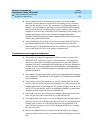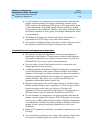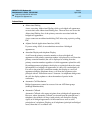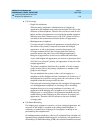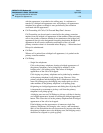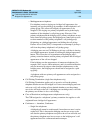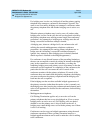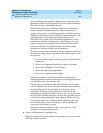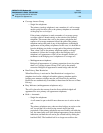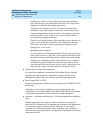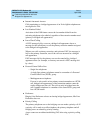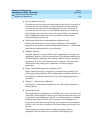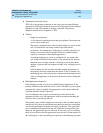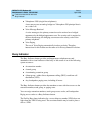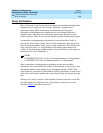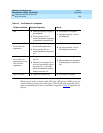
DEFINITY ECS Release 8.2
Administrator’s Guide
555-233-506
Issue 1
April 2000
Features and technical reference
1183Bridged Call Appearance
20
■ Coverage Answer Group
— Single-line telephones
The primary (analog) telephone is not a member of a call coverage
answer group, because calls to the primary telephone as a member
of the group are not bridged.
If the primary telephone is made a member of a coverage group,
coverage criteria is based entirely on the criteria of the primary
telephone. This means that a call to the primary telephone that
requires call coverage treatment follows the path of the primary
telephone and not the path of any of the telephones with bridged
appearances of the primary telephones. In this case, it is desirable to
have the bridging user in the coverage path of the primary telephone.
Then, when a call to the primary telephone requires coverage
treatment, it follows the coverage path to the bridging user’s
telephone, call appearances of the call are dropped, and the call
terminates at the bridging user’s telephone as a coverage call.
— Multiappearance telephones
Bridged call appearances of a primary extension do not ring when
there is a Coverage Answer Group (CAG) call to the primary
extension. Bridged call appearances cannot bridge onto the call.
■ Data Privacy, Data Restriction
When Data Privacy is activated or Data Restriction is assigned to a
telephone involved in a bridged call and the primary telephone and/or
bridging user attempts to bridge onto the call, Data Privacy and Data
Restriction are automatically overridden (or deactivated in the case of Data
Privacy).
■ Busy Indicator (multiappearance telephones only)
The call is placed to the resource from the first available bridged call
appearance for zero primary call appearance telephones.
■ Hold — Automatic
— Single-line telephones
A call cannot be put on hold if more than one user is active on that
call.
The primary telephone user, when no other bridges are active on the
call, can put the call on hold, using normal single-line hold
procedures. If the primary telephone user successfully soft holds the
call, the status lamp at all of the bridged appearances shows the hold
indication; and then the call can be put on hard hold by dialing the
hard hold FAC. The hard held call is no longer accessible to the



